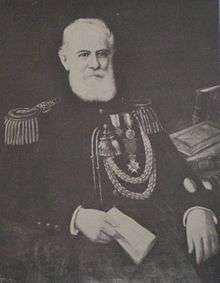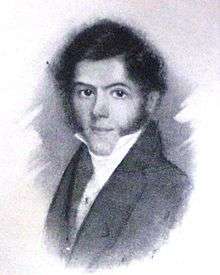Francisco Javier Muñiz
| Francisco Javier Muñiz | |
|---|---|
 Francisco Javier Muñiz | |
| Born |
21 December 1795 San Isidro, Argentina |
| Died |
8 April 1871 (aged 75) Buenos Aires, Argentina |
| Cause of death | Yellow fever |
| Resting place |
Cementerio de la Recoleta, Buenos Aires, Argentina 34°35′15.07″S 58°23′36.74″W / 34.5875194°S 58.3935389°W |
| Known for | Indigenous vaccine, physician |
Francisco Javier Muñiz (21 December 1795 – 8 April 1871) was an Argentine colonel, legislator, and medical doctor. He treated patients and died during the Great Yellow Fever Epidemic of 1871.[1] He was considered the first important naturalist from Argentina.[2]
Personal life
Francisco Javier Muñiz was born in San Isidro, Buenos Aires Province, Argentina on 21 December 1795.[3][4]
Early military service and medical school

He studied at the Instituto Médico Militar (Military Medical Institute) beginning in 1814.[4] The institute was founded by Dr. Cosme Argerich to train surgeons for the army.[5] Muñiz graduated as a doctor in 1821[3] He transferred to the University of Buenos Aires and completed his surgical education in 1824.[4] Muñiz obtained his doctorate in 1844; his dissertation was about the vaccination of indigenous peoples against smallpox. This work made him notable among European scientists.[4] His dissertation followed the article, "A Case of Extensive Scabby Ulcerations, Cured by Vaccination" that he wrote and was published in the London Medical and Surgical Journal in 1833.[2]
Career
Medicine
Muñiz, upon becoming a doctor in 1821, worked as a military doctor under Juan Lavalle at Carmen de Patagones during the campaign to secure land from indigenous people. He began to study the customs of native people at this time.[1] In 1824 he was transferred to the fort at Chascomús,[3][4] and began his study of paleontology.[4] General Carlos María de Alvear ordered that he accompany Lavalle and his troops during the 1826 war with Brazil. He was promoted to Army Surgeon Major that year and transferred to Luján in 1828 to be a physician to police and military troops.[4]
Muñiz served the military and became a colonel. During the Paraguayan War, he became director of Corrientes Province area hospitals.[3][6]
In 1848, Muñiz moved to Buenos Aires to become a professor of the School of Medicine where he taught in the fields of forensic medicine, gynecology and obstetrics.[3][6] He was dean, or president, of a Buenos Aires medical faculty.[1][3]
Paleontology
Muñiz was a paleontologist, particularly interested in variances among fossils.[3] Working as a physician at Lujan was of particular paleontological interest because of a famous find in 1788 of the Megatherium, an immense ground sloth. He developed a collection that he intended to be used to create a natural history museum. The artifacts were sent (donated or possibly donated by force) to Juan Manuel de Rosas,[4][7] the dictator of the Argentine Federation, whose support was required to establish a museum.[8] Rosas, in an attempt to build alliances overseas, sent collected fossils to Jean Henri Dupotet, Rear Admiral of the French Navy. Dupotet then sent them to Paris.[8] In France Muñiz collection ended up in the National Museum of Natural History where they were studied by Paul Gervais.[7]
Apuntes Toggraficos, published in 1847 by Muñiz, contained his topographical notes that discussed the study of fossils in the relative ages of sedimentary strata in areas south of the Buenos Aires Province by naturalists, including Charles Darwin.[4] Darwin began corresponding with Muñiz after reading his work on ñata cattle, indicative of the reputation that he was gaining as a naturalist. Domingo Sarmiento, who researched Muñiz's papers, commented on his influence to Darwin's theory of the origin of species.[9][10]
This inquiry into the existence and later extinction of a variety of cattle raised on the ranches of Buenos Aires would be of little intellectual interest today, were it not thus linked with the celebrated theory of evolution, and the appears of Dr. Muñiz would be of lesser interest, too, except for the observations cited by Darwin in the Journal of Researches (commonly known as The Voyage of the Beagle).[nb 1]— Domingo Sarmiento[9]
He described a sabertooth, which he named Muni-felus Bonaerensis, in Gaceta Mercantil in 1845.[11] He sent his description to Darwin on 30 August 1846 for his comments. Darwin encouraged him to send specimens to France, which were received in Paris, apparently sent by Rosas.[12] It was determined to be a Smilodon bonaerensis.[1]
In their book, From Man to Ape: Darwinism in Argentina, Novoa and Levine identify Muniz as the first important naturalist from Argentina,[2] who donated his later collection of fossils to the Museum of Buenos Aires.[1]
Politics
He was a legislator, elected first as a representative and then a senator.[3]
Death

After having treated people with yellow fever during the great Buenos Aires epidemic, Muñiz succumbed to the illness and died on 8 April 1871. He was buried in the Cementerio de la Recoleta in Buenos Aires, Argentina.[3][6] A monument was created in his honor by the city of Buenos Aires.[1]
Legacy
- Of his importance to Argentina, President Sarmiento wrote:
His profession was medicine and surgery; but at the University, he introduced and taught classes in obstetrics and pediatric pathology, exhibiting the highest feelings of respect for women, respect that in other countries had already led to calls for the civil equity of the sexes, and will soon lead also to political suffrage. Muñiz led the way along this path. In the army, he introduced vegetable rations and militated for mobile hospitals, such as now become the order of the day in all modern armies. In the natural sciences he followed in Darwin's footsteps, continuing his work and collecting the materials that Burmeister, with his greater technical skill, would later classify.
- The Museo de Historia Natural "Francisco Javier Muñiz" de Moreno was inaugurated in Moreno Partido in 1999 in his honor.[13]
- In a series commemorating scientists, Argentina issued a stamp with a portrait of Francisco Javier Muñiz in 1966.[3]
- Hospital Muñiz, the oldest Infectious Diseases Hospital in Latin America, is named in his honor.
Notes
- ↑ Darwin wrote: "A niata bull with a common cow, or the reverse cross, produces offspring having an intermediate character, but with the niata characters strongly displayed: according to Senor Muñiz, there is the clearest evidence, contrary to the common believe of agriculturalists in analogous cases, that the niata cow when crossed with a common bull transmits her peculiarities more strongly than the niata bull when crossed with a common cow."[9]
References
- 1 2 3 4 5 6 Sir Norman Lockyer (1917). Nature. Macmillan Journals Limited. p. 305.
- 1 2 3 Adriana Novoa; Alex Levine (1 December 2010). From Man to Ape: Darwinism in Argentina, 1870–1920. University of Chicago Press. p. 31. ISBN 978-0-226-59616-7.
- 1 2 3 4 5 6 7 8 9 10 Marc A. Shampo, PhD, Robert A. Kyle, M.D. (October 1989). "Francisco Javier Muñiz: Argentinean Physician, Geologist, and Paleontologist". 64 (10). Mayo Clinic Proceedings (online version): 1302. Retrieved 19 December 2013.
- 1 2 3 4 5 6 7 8 9 Alex Levine; Adriana Novoa (5 January 2012). ¡Darwinistas! The Construction of Evolutionary Thought in Nineteenth Century Argentina. BRILL. p. 85. ISBN 978-90-04-22136-9.
- ↑ "Cosme Mariano Argerich (1758–1820)". Instituto de Enseñanza Superior del Ejército Argentino. Retrieved 20 December 2013.
- 1 2 3 4 Alex Levine; Adriana Novoa (5 January 2012). ¡Darwinistas! The Construction of Evolutionary Thought in Nineteenth Century Argentina. BRILL. p. 90. ISBN 978-90-04-22136-9.
- 1 2 Barquez, Rubén M.; Díaz, M. Mónica (2014). "History of mammalogy in Argentina". In Ortega, José; Martínez, José Luis; Tirira, Diego G. Historia de la mastozoología en Latinoamérica, las Guayanas y el Caribe (PDF) (in Spanish). Editorial Murciélago Blanco y Asociación Ecuatoriana de Mastozoología. pp. 15–50. Retrieved 16 January 2016.
- 1 2 Adriana Novoa; Alex Levine (1 December 2010). From Man to Ape: Darwinism in Argentina, 1870–1920. University of Chicago Press. p. 32. ISBN 978-0-226-59616-7.
- 1 2 3 Alex Levine; Adriana Novoa (5 January 2012). ¡Darwinistas! The Construction of Evolutionary Thought in Nineteenth Century Argentina. BRILL. pp. 85–87. ISBN 978-90-04-22136-9.
- ↑ Leila Gómez (2012). Darwinism in Argentina: Major Texts (1845–1909). Lexington Books. p. 7. ISBN 978-1-61148-386-4.
- ↑ Alex Levine; Adriana Novoa (5 January 2012). ¡Darwinistas! The Construction of Evolutionary Thought in Nineteenth Century Argentina. BRILL. pp. 87–90, 91–95. ISBN 978-90-04-22136-9.
- ↑ Alex Levine; Adriana Novoa (5 January 2012). ¡Darwinistas! The Construction of Evolutionary Thought in Nineteenth Century Argentina. BRILL. pp. 87–88. ISBN 978-90-04-22136-9.
- ↑ "Apertura de las actividades en el Museo Javier Muñiz". Moreno Municipio. 20 August 2013. Retrieved 20 December 2013.
Further reading
- Babini, José, La Ciencia en la Argentina. Biblioteca de América, libros del tiempo nuevo. EUDEBA, 1963. (Spanish)
- Chávez, Fermín, La cultura en la época de Rosas, Bs. As., 1991. (Spanish)
- Gómez, Leila, "Francisco Javier Muniz, The Muni-Felis Bonaerensis". Darwinism in Argentina: Major Texts (1845–1909). Lexington Books. pp. 41–48, 2012. ISBN 978-1-61148-386-4. (English)
- Nicolau, Juan Carlos, Ciencia y técnica en Buenos Aires 1800–1860. Ed. EUDEBA, Bs. As., 2005. ISBN 950-23-1429-8 (Spanish)
| Wikimedia Commons has media related to Francisco Javier Muñiz. |